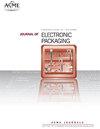利用纳米铜线实现瞬态液相键合加速
IF 2.2
4区 工程技术
Q3 ENGINEERING, ELECTRICAL & ELECTRONIC
引用次数: 0
摘要
电力电子模块中不断增加的热通量正在挑战热管理技术的极限。这是由于宽带隙半导体器件具有卓越的电压阻断能力。如果封装得当,这些器件也能在较高的结温下工作。瞬态液相键合形成的金属间化合物在常规加工温度下具有较高的熔化温度。使用纳米铜线可以加速 SAC305 焊接键中铜和锡瞬态液相金属间化合物的形成。这项工作探索了使用焊料和纳米线加速瞬态液相键合的可行性。这包括纳米线的电铸、纳米线上焊料的接触角分析、使用扫描声学显微镜和横截面扫描电子显微镜进行空隙分析。使用 75 微米钢网将 SAC305 焊料沉积在直径为 0.4 微米的纳米铜线基底上,然后进行回流焊。结果发现,在 260 °C 的大气中储存 2 小时后,金属间结合区域完全形成。采用这种纳米线瞬态液相键合方法完成键合的剪切强度平均为 11.99 公斤或 13 兆帕。本文章由计算机程序翻译,如有差异,请以英文原文为准。
Transient Liquid Phase Bond Acceleration Using Copper Nanowires
Increasing heat flux in power electronics modules is taxing the limits of thermal management technologies. This is the result of wide bandgap semiconductor devices with superior voltage blocking capabilities. These same devices have the capability of operating at elevated junction temperatures when properly packaged. Transient liquid phase bonding forms intermetallic compounds with high melting temperatures at more conventional processing temperatures. Copper and tin transient liquid phase intermetallic formation in SAC305 solder bonds can be accelerated using copper nanowires. This work explores the feasibility of accelerated transient liquid phase bonding using solder and nanowires. This includes electroforming of nanowires, contact angle analysis of solder on nanowires, void analysis using scanning acoustic microscopy and cross-sectional scanning electron microscopy. SAC305 solder is deposited on substrates with 0.4 µm diameter copper nanowires using a 75µm stencil and subjected to solder reflow. It is found that atmospheric storage at 260 °C results in regions of complete intermetallic bonding after 2 hours. Shear strength of bonds completed with this nanowire transient liquid phase bonding method averages 11.99 kg or 13 MPa.
求助全文
通过发布文献求助,成功后即可免费获取论文全文。
去求助
来源期刊

Journal of Electronic Packaging
工程技术-工程:电子与电气
CiteScore
4.90
自引率
6.20%
发文量
44
审稿时长
3 months
期刊介绍:
The Journal of Electronic Packaging publishes papers that use experimental and theoretical (analytical and computer-aided) methods, approaches, and techniques to address and solve various mechanical, materials, and reliability problems encountered in the analysis, design, manufacturing, testing, and operation of electronic and photonics components, devices, and systems.
Scope: Microsystems packaging; Systems integration; Flexible electronics; Materials with nano structures and in general small scale systems.
 求助内容:
求助内容: 应助结果提醒方式:
应助结果提醒方式:


